If you’re shopping for a durable mattress that’s comfortable, supportive, and made from natural materials, then a latex mattress may be just the thing.Uncover what’s inside a latex mattress and why this natural textile is used to make mattresses that are comfortable, durable, and eco-friendly.
What Is Latex?
Natural latex is the liquid sap of the Hevea brasiliensis rubber tree.
Once the liquid is tapped from a rubber tree, it is transformed into latex that can be used in mattresses, furniture, dog beds, chewing gum, sporting goods, swim caps, gloves, balloons, tennis shoes, rubber tires, and many other consumer and medical-grade goods.
Latex sap can be sustainably harvested from a rubber tree for 30 years; the tree does not need to be cut down to harvest the liquid.
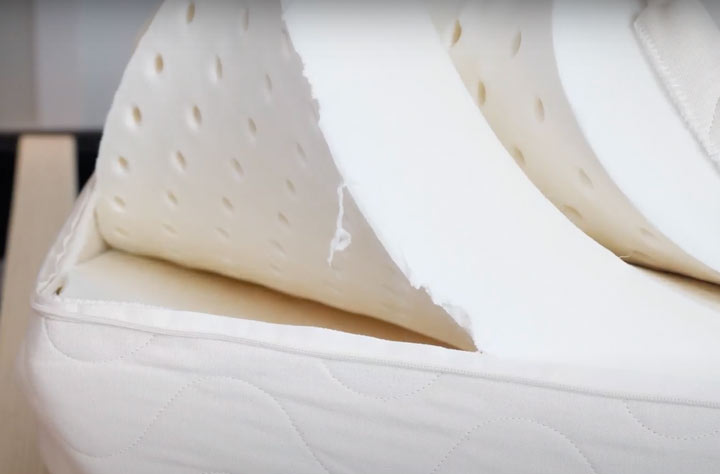
Types of Latex
If you’re shopping for a latex mattress, you may notice that manufacturers utilize two different types of latex. Is one type of latex better than another?
All natural latex comes from the same type of Hevea brasiliensis rubber plant; it’s the next step of the manufacturing process that determines the “type” of latex used in your mattress.
- Dunlop Latex: liquid latex is poured into a mold and then vulcanized in an oven. The process is more energy efficient than Talalay, and the resulting latex foam is “springy” and more dense than Talalay.
- Talalay Latex: liquid latex is poured halfway into a mold and then vacuum expanded, frozen, and “gelled” with carbon dioxide before the temperature is increased to vulcanize the foam. The process is less energy efficient than Dunlop and the resulting latex foam is “bouncy” and less dense than Dunlop.
Is Latex Natural?
Natural latex is a natural, vegan, sustainable plant-based material.
While natural latex comes from a plant, not all latex mattresses are completely chemical-free. Some manufacturers may include layers of memory foam or synthetic foam—a non-natural material made from petrochemicals—into their products. Some may incorporate fire-retardant chemicals or other synthetic fabrics and materials into their mattresses as well.
If you are searching for a latex mattress that is as close to natural as possible, then look for manufacturers who use only natural materials and seek organic certifications, such as Oeko-Tex or GOTS certification.
What is a Latex Mattress Made of?
The construction of a latex mattress can vary depending on the manufacturer. Some latex mattresses consist of nothing more than layers of latex wrapped in a fabric cover. Others contain additional elements, such as coils and memory foam.
Here are some of the layers or materials you may find in a latex or latex-hybrid mattress:
- Latex: either Dunlop or Talalay
- Coils: a support layer of springs (also called innersprings, spring coils, or pocketed coils)
- Cover: wrapping all of the elements together, many latex mattress covers are made from natural materials such as wool and organic cotton
Some mattresses may have a synthetic foam layer to provide additional support or comfort.
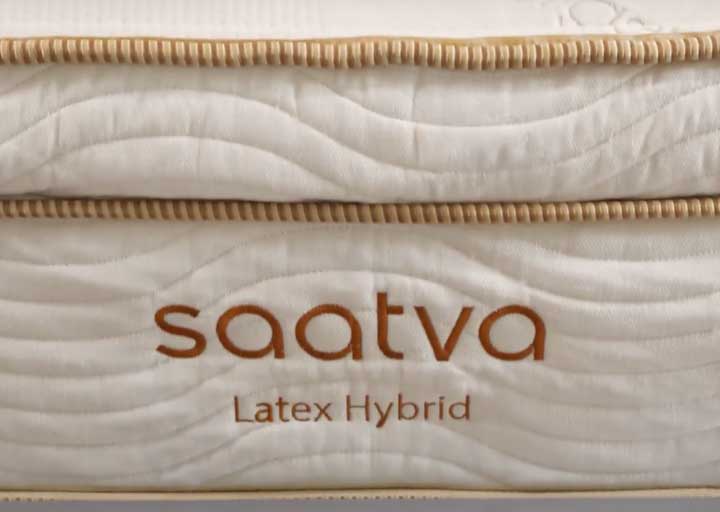
Are Latex Mattresses Toxic?
Most latex mattresses are constructed entirely out of non-toxic and organic materials, such as natural latex, metal coils, wool, and organic cotton. Because they do not off-gas Volatile Organic Compounds (VOCs) or contain fire-retardant chemicals, the majority of latex mattresses are considered non-toxic and organic mattresses that can help contribute to cleaner indoor air quality at home.
Can You Be Allergic to Latex Mattresses?
Latex can be the perfect hypoallergenic mattress; it naturally inhibits common allergens such as dust mites, mildew, and mold.
While a latex mattress has many benefits and is good for most allergy sufferers, there is one major drawback: it may not be a good choice for people with severe latex allergies.
Natural latex contains up to 15 allergenic proteins that can trigger a reaction in latex-sensitive people. For those with latex allergies, contact can lead to allergy and asthma symptoms, contact dermatitis, and, in severe cases, anaphylactic shock.
So, should you sleep on a latex mattress if you have a latex allergy?
During the manufacturing process, latex is washed multiple times, removing many of the problematic latex proteins. The latex layer is then wrapped in a cover during the construction of a mattress, so the latex itself will never come into direct contact with your body.
For some people with mild latex allergies, sleeping on a latex mattress poses no problem. However, if you or someone in your household has a severe latex allergy, or just wants to play it safe and not roll the dice, it may be best to find a hypoallergenic latex-free alternative.
What Does a Latex Mattress Feel Like?
Sleeping on a latex mattress is a cool, supportive experience. The unique properties of this natural mattress provide a unique feel that’s unlike many other mattress types.
Sleeps Cool
Latex has an internal open cell structure that allows for airflow and, unlike polyurethane foams like memory foam, latex won’t trap body heat. Latex mattresses with an innerspring or pocketed coil design further allow for airflow throughout the mattress. Lastly, many latex mattresses contain wool; which helps regulate temperature and wick away moisture.
Supportive, Bouncy, and Buoyant
The feel of a latex mattress is often described as buoyant: instead of sinking into your mattress, you’ll float on top. It doesn’t sink or sag when you lie down.
A pure latex mattress without springs is supportive, cradling your joints and naturally aligning your body. A hybrid latex mattress with pocketed coils or innersprings can add even more support for your body. And latex mattresses are available in a variety of firmness levels.
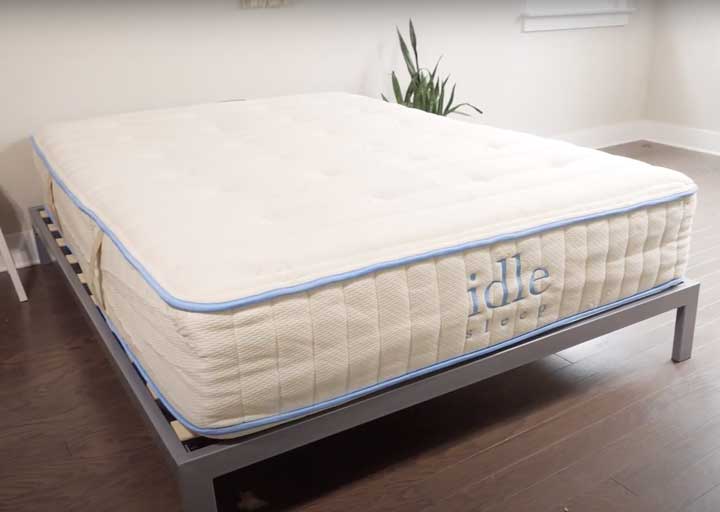
Latex Mattress Pros and Cons
Pros
- Natural: latex is a natural vegan material that comes from the Hevea brasiliensis rubber tree
- Sustainable and eco-friendly: latex is sustainably harvested and can biodegrade, making it an environmentally-friendly mattress choice
- Non-toxic: latex mattresses off-gas fewer VOCs and contain fewer synthetic materials and chemicals compared to polyfoam mattresses
- Organic: many latex mattresses are certified-organic or made with certified-organic materials
- Comfortable and supportive: latex mattresses are naturally supportive and buoyant and don’t sag or sink
- Long-lasting: latex mattresses may last up to 20 years or longer if well-cared for (that’s double or even triple the lifespan of a conventional mattress)
- Cool: latex is naturally cooling and the addition of innersprings and wool amplifies its cooling effects
- Hypoallergenic: latex naturally inhibits dust mites, mildew, and mold
Cons
- Price point: some latex mattresses may come at a higher price than other mattresses. Natural materials are often higher-priced than synthetic materials, making these products more expensive
- Weight: latex mattresses can weigh more than a conventional mattresses, so moving or rotating it can be difficult
- Odor: some consumers say their latex mattress had a distinctive smell at first
- Synthetics: some manufacturers use synthetic rather than natural latex or incorporate synthetic foams and materials into their natural latex mattresses, which can take away from the non-toxic or eco-friendly properties one expects from a natural latex mattress
- Latex allergy: while latex mattresses are hypoallergenic and may be safe for someone with less-severe latex allergies, those with severe allergies may want to avoid
How Do Latex Mattresses Compare to Other Mattresses?
Are you comparing a latex mattress to one made of memory foam or springs? Here’s what you should know about how a latex mattress compares to these other popular mattress choices:
Latex vs Memory Foam
The biggest difference between a latex vs memory foam mattress is natural vs synthetic materials. Natural latex is derived from the rubber tree and does not off-gas as many chemicals as a memory foam mattress, which is made from polyurethane. Polyurethane foam is derived from a petrochemical, and because it is highly flammable, mattresses made from this foam are treated with chemical fire retardants during manufacturing. Memory foam beds tend to have far higher VOCs than latex ones.
Latex has a springy buoyancy while memory foam offers a sinking feeling. Latex will bounce back and maintain its supportive feel when you lie down on it, while memory foam conforms around your body (a benefit for sleepers with joint pain of any kind). If you sleep with a partner, memory foam is superior for absorbing movement. Lastly, if sleeping cool is your main concern, then latex is the better choice. Its open-cell structure traps less heat than memory foam.
Latex vs Innerspring
An innerspring mattress contains a supportive layer of springs or coils topped with a comfort layer of foam and fabric. The comfort and support of an innerspring mattress will depend on the number of coils and what type of materials are used in the comfort layer.
Innersprings offer good bounce and support. Latex mattresses have some natural bounce and springiness, however, but they won’t give you the same trampoline-type bounce that an innerspring mattress does.
Conventional innerspring mattresses often contain synthetic materials such as polyfoam as well as chemical fire retardants. If you’re looking for a mattress with fewer chemicals, then latex is the winner.
Latex mattresses are long-lasting and more durable than innerspring. Where a traditional mattress should be replaced every 7 to 10 years, a latex mattress can last for 20 years or more. While the initial price tag of a latex bed may be higher, you may save money in the long run by purchasing a more durable, long-lasting mattress.
Latex vs Hybrid
A true latex mattress consists only of layers of latex wrapped in a cover. A hybrid mattress features a support layer of springs and coils, much like an innerspring mattress, combined with comfort layers that can be made of memory foam or latex. Hence the name hybrid: it often combines the best of both worlds.
If you’re looking for all of the benefits of latex but want that extra-supportive layer of innersprings, then a latex hybrid may be the right choice. A latex hybrid also amplifies the natural cooling properties of a latex mattress by providing the opportunity for more airflow to circulate around the springs.
RELATED: Latex vs Hybrid Mattress
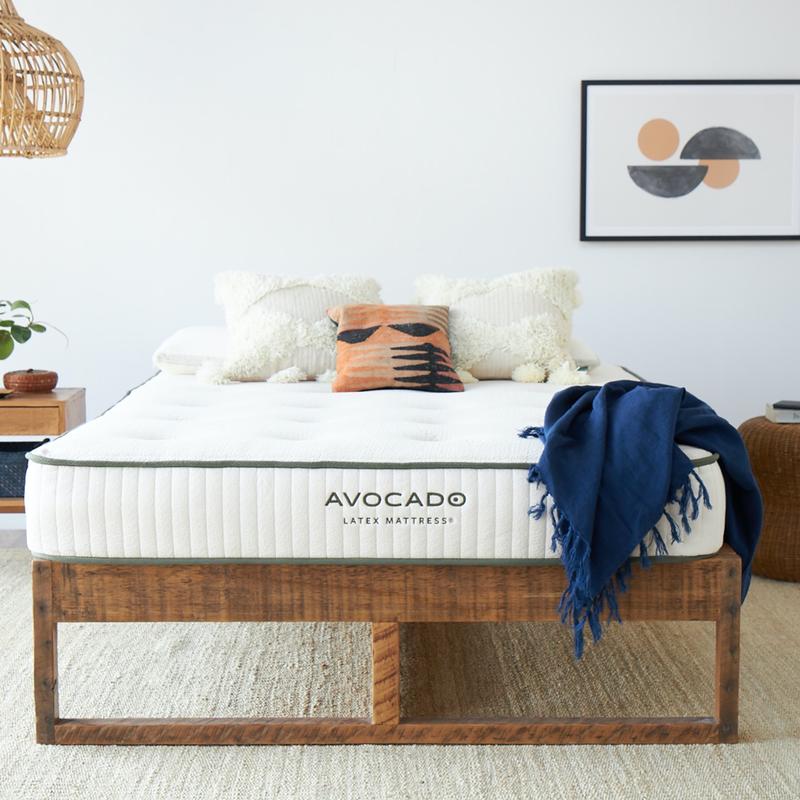
How Long Does a Latex Mattress Last?
A latex mattress is a long-lasting investment that can last up to 20 years or longer. A conventional mattress lasts around 7 to 10 years. Memory foam and other polyfoam materials break down over time, slowly wearing out due to friction and moisture. Latex doesn’t break down like other mattresses do. Plus it naturally inhibits the mildew and mold that can shorten a mattress’ lifespan. Many latex mattress manufacturers offer 10-year or even 20-year warranties for their products.
Do Latex Mattresses Need a Box Spring?
Latex and latex hybrid mattresses don’t require a box spring. They can be placed on a platform bed frame or, if you want more height for aesthetic purposes, a box spring. But the box spring is not needed to increase the support or comfort of a latex mattress.
Can You Flip a Latex Mattress?
A latex mattress does not require flipping. Unlike some cheaper polyfoam mattresses that can start to wear and sag over time, a latex mattress maintains its shape.
How to Clean a Latex Mattress
Since your latex mattress will likely last you for a decade or two, keeping it clean can help you enjoy it for the entire duration.
Before you clean your mattress, be sure to take a look at the manufacturer’s care tag so you know what materials it consists of.
- Use a microfiber towel to absorb any liquid from the mattress.
- Spot clean the surface. Follow this mattress cleaning guide for removing specific stains such as blood or urine from your mattress.
- Avoid using harsh detergents or chemicals.
- Let your mattress air dry completely after cleaning.
Who Should Get a Latex Mattress?
A latex-hybrid or latex mattress is a great choice for anyone who wants a natural and environmentally-friendly mattress that’s comfortable and long-lasting. Latex is hypoallergenic and great for allergy sufferers, however, for people with severe latex allergies, it may not be the best solution.
What to Look for When Buying a Latex Mattress
If you’re looking to buy a latex mattress because you want an organic, non-toxic, more natural product for your home, then you’ll want to seek out a mattress with the following:
- Natural latex (Dunlop or Talalay), not synthetic latex
- Organic certifications for materials
- No added layers of memory foam (polyurethane)
- Manufacturer warranty of ten years or longer
Who Should Get a Latex Mattress Topper?
If you want to experience the comfort and support of a latex mattress without the financial investment, you may want to consider a latex mattress topper. A latex topper can help you determine if latex is the right choice for your body and sleeping style before purchasing the full mattress. It can also help you extend the life of a sagging or dipping mattress, or help provide a cooling layer to a memory foam mattress that has you overheating at night.
What to Look for When Buying a Latex Mattress Topper
When looking for a latex mattress topper, look for the same quality as you would in a mattress. You want to find a quality topper that is made from real natural latex, not synthetic latex. Ensure there are no other synthetic materials or petrol foam added, and find out if the manufacturer offers a warranty.
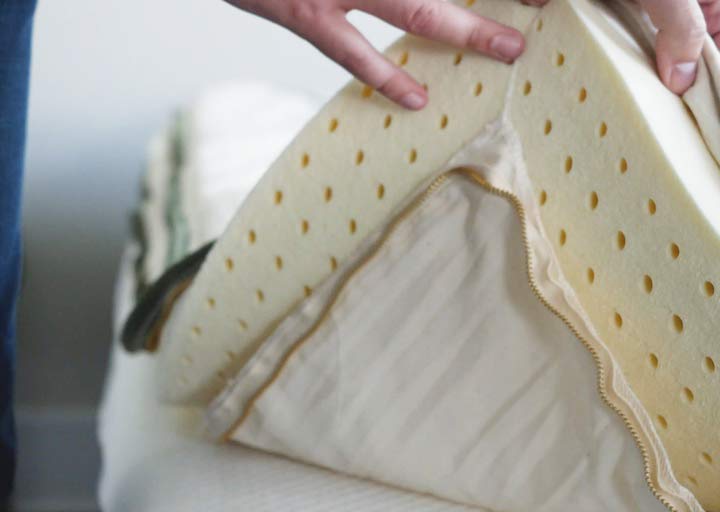
Who Should Get a Latex Pillow?
If you find yourself waking up with neck pain or numbness in your hands or arms, you may want to consider a supportive and buoyant latex pillow. Latex pillows come in different sizes and types. Some are made from a single piece of molded latex, while others consist of shredded latex mixed with other materials for added comfort.
What to Look for When Buying a Latex Pillow
The best latex pillows will consist of molded natural latex or shredded latex combined with other natural materials. Choose the right pillow for your body size and sleeping style. Side sleepers usually need a bit more height in their pillow than back sleepers, while stomach sleepers need a pillow that is relatively flat. However you sleep, you’ll want to ensure your latex pillow aligns your back and spine.
FAQs
Are latex mattresses hot?
A latex mattress is an excellent cooling mattress. Natural latex has cooling properties that are enhanced when paired with wool and pocketed coils, which encourage airflow and wick moisture away from the body.
Are latex mattresses heavy?
Latex mattresses are dense and heavier than conventional innerspring mattresses. Latex-hybrid mattresses with pocketed coils can add even more weight to the mattress.
Are natural latex mattresses safe?
Natural latex mattresses are hypoallergenic and safe for everyone except those with severe latex allergies.
Do latex mattresses sag?
Latex mattresses are durable and long-lasting. Many can last for up to 20 years. Unlike polyfoam mattresses that can dip and sag over time, with a latex mattress you won’t have to worry about fixing a sagging mattress anytime soon.
Are latex mattresses good for back pain?
Many people with back pain swear by latex mattresses. Latex provides a supportive sleeping surface that doesn’t dip or sink, helping your body stay aligned while sleeping.
Are latex mattresses good for side sleepers?
Latex mattresses can work for all types of sleepers. However, the same supportive properties that make this an ideal mattress for people with back pain may not make it the best mattress for side sleepers. If you sleep on your side, you may sleep a bit better with a memory foam mattress that can conform to your body.

